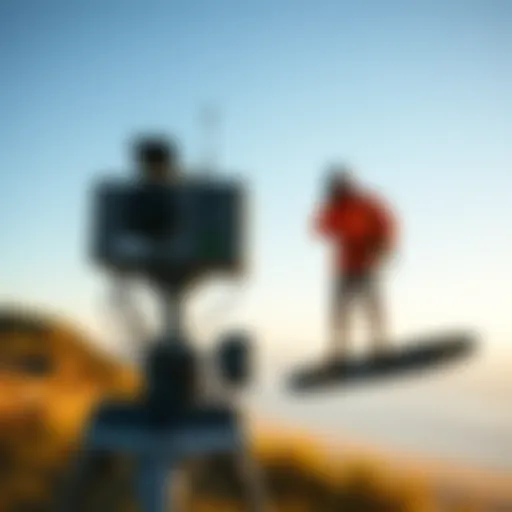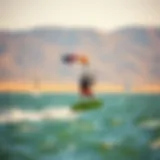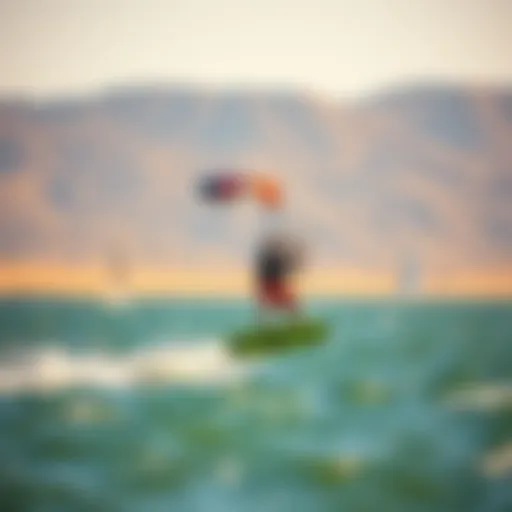Choosing the Right Wetsuit for Cold Water Kiteboarding


Intro
When kiteboarding in colder waters, choosing the right wetsuit isn't just a matter of preference; it can significantly impact your comfort and performance. The chill of frigid water can sap your energy and diminish the thrill of riding the waves, and that's where a well-selected wetsuit comes into play. Fortunately, there’s a wealth of information out there to help you navigate the myriad choices available, ensuring you make informed decisions that align with your specific needs and kiteboarding style.
In this guide, we will dissect the nuances of selecting the ideal wetsuit for cold water kiteboarding. We’ll touch on various materials that promote warmth, delve into the array of thickness options, and examine the latest technologies designed to enhance both flexibility and performance. It's essential to understand how to find the right fit, as well as the different conditions each suit might see.
Gear Insights
Getting the right wetsuit begins with understanding what’s currently available. Research and reviews can help you decide on your purchase, so let’s jump right in.
Latest Gear Reviews
In recent years, wetsuit technology has evolved dramatically. Brands are now widely focusing on warmth, flexibility, and comfort. A standout in this arena is the O'Neill Psycho Tech 5.5/4.5mm wetsuit, which features revolutionary water-repellent materials that keep you warmer far longer compared to traditional suits. It offers a snug fit with no excess bulk, allowing for full range of motion while also ensuring durability. Another noteworthy mention is the Xcel Drylock 4/3mm. This suit employs a unique thermal lining, providing excellent insulation while not compromising on lightweight comfort.
A good way to sift through options is to rely on communities such as Reddit or forums where fellow kiteboarders share their experiences. The dialogue can guide you to the best suited brands and models.
Essential Gear for Beginners
If you are new to kiteboarding in cold waters, starting right is crucial. Besides a top-quality wetsuit, you'll want to consider a few additional pieces:
- Booties: These are vital for warmth and grip, preventing your feet from becoming numb and ensuring you don't slip on your board.
- Gloves: Keep your hands warm and nimble; look for those that provide a good grip without sacrificing flexibility.
- Hoods: They may not seem essential, but a hood can retain heat and protect against wind chill, making your session far more enjoyable.
Arming yourself with the right gear allows you to focus more on the wind, waves, and thrill of the ride rather than the cold biting at your skin.
Techniques and Tips
When kiteboarding in colder climates, it's paramount to adopt techniques that enhance your overall experience and safety in chilly waters.
Advanced Tricks and Techniques
Once you’ve got your wetsuit sorted, it's time to enhance your skills. During cold water kiteboarding, body posture is key; keeping your core tight and shifting your weight properly can maintain balance more effectively. Practice transitions and jumps frequently, as these will not only build your confidence but also help to keep the thrill alive despite the cold.
Safety Practices for Kiteboarders
Cold water presents unique challenges you must be aware of:
- Buddy System: Always ride with a partner; in case of an emergency, someone is there to help.
- Check Weather Conditions: Before heading out, ensure you check updates to avoid unexpected hazards.
- Know Your Limits: It’s easy to push boundaries; however, in colder climates, knowing when to take a break is vital to avoid exhaustion and hypothermia.
As you continue to refine your skills and navigate the waters, remember that staying warm and comfortable is an integral part of your success on the board.
"The proper gear and techniques can make the difference between a thrilling day on the water and a soggy disappointment."
Ultimately, as you delve deeper into kiteboarding in chillier waters, you’ll want to reflect on both your equipment and approach. Tailoring your choices to fit your unique style and the conditions at hand will lead to a more fulfilling kiteboarding experience.
Understanding Cold Water Conditions
The world of kiteboarding is as exhilarating as it can be challenging, especially when the temperature dips. Understanding cold water conditions is crucial to maintaining both safety and performance while out on the waves. Kiteboarders must grasp how cold water affects their gear, body, and overall riding experience.
Defining Cold Water
Cold water is generally categorized as water that has a temperature lower than 15 degrees Celsius (59 degrees Fahrenheit). While this number can vary slightly based on individual tolerance, it serves as a useful baseline for kiteboarders.
Engaging in this sport during colder months can present unique challenges, not just in enjoying the ride but also in ensuring physical well-being. It’s not just the chill that you feel; prolonged exposure can lead to hypothermia, loss of mobility, and diminished performance.
Kiteboarders should be aware of how various geographical locations can affect water temperatures. For example, the Pacific Northwest in the United States may boast frigid waters year-round, while certain areas in the Mediterranean might only get chilly during the winter months. Each region's characteristics will necessitate various approaches to gear and riding style.
Impacts on Kiteboarding Experience
Riding in cold water fundamentally alters your kiteboarding experience. Here are a few effects you might encounter:
- Physical Limitations: Cold water can sap your body’s heat quickly. As your core temperature drops, your muscles may also constrict, leading to slower reaction times. A kiteboarder can't perform at their peak if they're shivering and losing strength.
- Gear Considerations: The demand for high-quality wetsuits becomes even more pressing. A subpar wetsuit can feel pretty much like trying to ride with a lead weight around your ankle. Thermal protection is key for optimal performance.
- Mental State: Riding in cold conditions often requires a heightened mental alertness. You can't afford to drift into a foggy state of mind when you're battling wintry elements in the water. A clear and focused mindset allows you to respond more tangibly to changing conditions, be it the wind direction or the size of the waves.
- Environmental Awareness: Understanding cold conditions also involves recognizing how sea currents work and their potential dangers. Knowledge of local geography can make a huge difference.
Kiteboarders who take the time to familiarize themselves with the impacts of cold water can not only enhance their safety but also enjoy a more fulfilling experience on the water. Adapting to these conditions is not just about putting on a wetsuit; it’s about preparing both mind and body for challenges unique to colder climates. By doing so, kiteboarders can minimize risks and fully embrace the thrill of cold water kiteboarding.
The Role of Wetsuits in Kiteboarding
Kiteboarding, especially in cold waters, is often a thrilling yet challenging pursuit. A crucial component of navigating those chilly waves effectively is the wetsuit. Wetsuits serve as the barrier between the cold, merciless water and a kiteboarder's body, providing essential elements that enhance both safety and performance.
Thermal Insulation
When it comes to thermal insulation, warmth is non-negotiable. Cold water can sap your energy quickly, leading to discomfort that distracts you from the exhilarating experience of kiteboarding. The materials and design of modern wetsuits—typically made from neoprene—are engineered to trap a thin layer of water between the suit and your skin. The body then gradually warms this water, creating an insulating layer that helps maintain a stable temperature. This process is akin to wearing a warm blanket.
Thicker wetsuits offer better insulation against the cold, allowing kiteboarders to enjoy longer sessions without succumbing to the chill. However, it’s important to strike a balance; a wetsuit that’s too thick can restrict your movement and performance. Depending on the water temperature, a 4/3 mm or even a 5/4 mm thickness may be advisable for colder seasons. Additionally, the placement of insulation varies by models. Some suits have extra insulation around the core while utilizing thinner materials on the limbs, enabling flexibility where it matters most for maneuverability.
Protection from Elements
In addition to thermal insulation, wetsuits provide significant protection from environmental elements. Kiteboarders face more than just cold water; wind, UV rays, and abrasions from equipment or the ocean floor can seriously affect both safety and enjoyment. A well-fitted wetsuit helps shield against these elements.
Wind chill can leave even seasoned riders feeling the bite. A wetsuit offers wind-resistant properties, reducing the wind's cooling effect as you glide across the waves. It’s as if you’re putting on an extra layer of defense.
Furthermore, exposure to UV rays can be deceptively dangerous, even on overcast days. Many modern wetsuit designs factor in UV protection, ensuring that you can kiteboard safely without risking sunburn.
Moreover, for those who take a dive—whether due to a mishap or simply to catch a wave—wetsuits with reinforced seams and padding protect the body from cuts and scrapes. This is especially crucial in rocky coastal areas or places with natural debris. Investing in a quality wetsuit yields far more than just warmth; it provides an assurance of safety and comfort that any kiteboarder should prioritize.
"Choosing the right wetsuit can mean the difference between a memorable day on the water and a night spent shivering on the beach."
Types of Wetsuits for Cold Water
Selecting the right wetsuit for kiteboarding in cold water goes beyond just choosing something that looks good. It’s about understanding how different styles can significantly impact comfort and performance. Each type of wetsuit serves a specific purpose and comes with its own set of advantages. Knowing which wetsuit to wear can make the difference between a pleasurable session on the water and an experience that leaves you shivering to the bone.
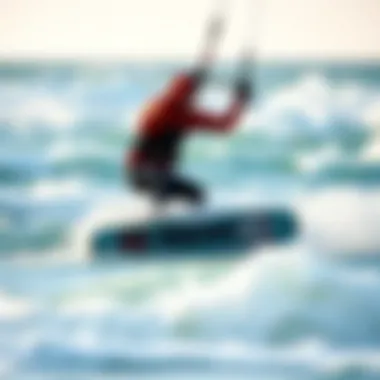
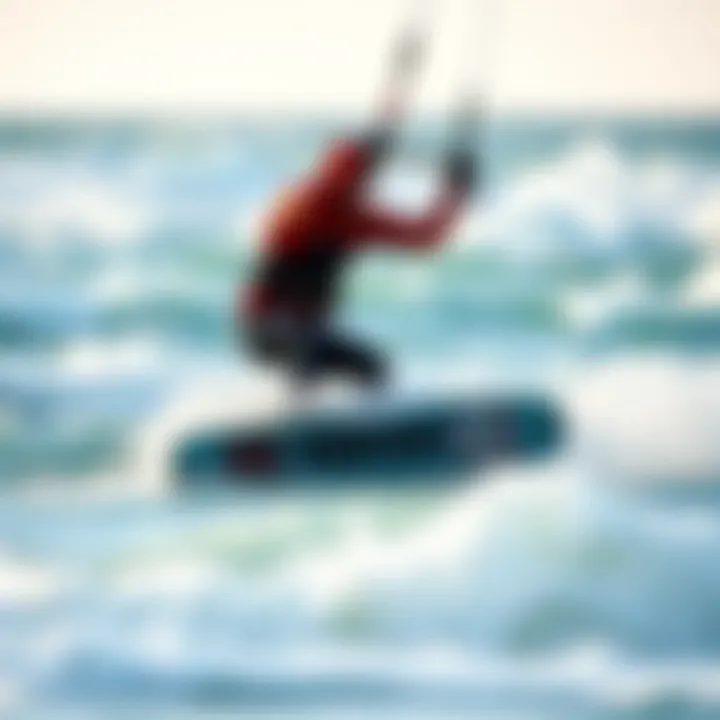
Full Suits
Full suits, also known as "steamer suits", are a popular choice among kiteboarders tackling colder waters. As the name suggests, these suits cover the entire body, providing comprehensive thermal insulation. They are designed with long sleeves and legs, which keep every bit of you warm, even on the chilliest of days.
One of the key benefits of full suits is their ability to trap body heat. The snug fit, when paired with quality neoprene materials, helps to maintain warmth. Additionally, many full suits come with features like thermal lining and sealed seams that enhance insulation, preventing water from seeping in. The snugness and coverage keep kiteboarders feeling cozy, allowing them to focus on their riding skills rather than the brisk bite of the water.
On the downside, full suits can feel restrictive at times. The thickness meant to keep you warm may reduce flexibility. However, advancements in wetsuit technology, like the use of super-stretch neoprene, have incorporated more pliability without compromising on warmth.
Shorties
Shorties, or short wetsuits, cover the upper body but leave the arms and legs exposed. These are ideal for kiteboarders who are in slightly warmer cold water conditions or those who generate enough body heat during their intense activity. Perfect for spring or early fall, shorties are a more comfortable option when temperatures begin to climb, but the water is still on the cool side.
The primary advantage of a shorty is its breathability and freedom of movement. With unrestricted arms and legs, riders can maneuver their boards more effectively. Additionally, the ease of putting on and taking off a shorty makes it a practical choice for those looking for quick sessions after work or during lunch breaks.
However, it’s worth noting that shorties provide less thermal protection than full suits. In particularly cold conditions, kiteboarders may find themselves cold and may need to supplement their suit with other thermal layers or accessories, such as thermal vests or gloves.
Hybrid Suits
Hybrid suits combine features of both full suits and shorties. Typically, they have long legs but short sleeves, offering a great compromise between warmth and flexibility. These suits allow for better mobility in warmer months when staying cool is still a priority, while providing enough coverage for a chill. They are becoming increasingly popular among kiteboarders who want a versatile option.
The versatility of hybrid suits lies in their ability to function in varied water temperatures. For example, they can easily transition from warmer summer sessions to cooler late-season riding. This adaptability can be crucial for kiteboarders who chase winds and conditions across regions with fluctuating climates.
However, similar to shorties, hybrid suits may not offer the same level of insulation of a full suit. Riders should evaluate local conditions and personal cold tolerance when considering a hybrid suit for cold water kiteboarding.
"The type of wetsuit you choose is paramount not just for comfort, but for performance on the water. Your ride can change dramatically based on your insulation choices."
Each wetsuit type brings its own nuances and benefits, making it essential for kiteboarders to consider their local conditions and individual needs when making a decision. With the right suit, you can take on the elements confidently, focusing on the thrill rather than the chill.
Materials Used in Wetsuits
Understanding the materials that go into wetsuits is critical for kiteboarders, especially when it comes to facing the chillier waters. Each type of material comes with its advantages and trade-offs, and the right choice can make a world of difference when braving cold water. Here, we will delve into the most common types of materials used in making wetsuits and their respective benefits.
Neoprene Variations
Neoprene is the superhero of wetsuit materials. It’s the stuff that keeps you warm because of its insulative properties, which trap a thin layer of water against your skin that eventually warms up. Not all neoprene is created equal, however. There are variations to consider:
- Standard Neoprene: This traditional version is suitable for most conditions. It’s effective but can be a bit bulkier.
- Super Stretch Neoprene: As the name suggests, this type allows for greater freedom of movement, which kiteboarders will greatly appreciate during tricks and maneuvers.
- Limestone Neoprene: This more eco-friendly alternative is made from limestone rather than petroleum. It offers excellent insulation while also being lighter in weight.
Notably, the thickness of neoprene varies as well, ranging typically from 2mm to 6mm, depending on the water temperature. A thicker suit will provide more warmth, but may also restrict movement, so it’s always a balancing act. Choosing the right neoprene thickness is vital based on where and when you kite.
Eco-Friendly Options
Now, with the rising focus on sustainability, more brands are turning their eyes toward eco-friendly wetsuit options. Kiteboarders are starting to care not just about what suits them best, but also what impacts their environments.
- Natural Rubber: Some manufacturers are using natural rubber derived from rubber trees. This material is biodegradable and can offer comparable warmth to traditional neoprene.
- Recycled Materials: Many brands are using recycled plastics or fishing nets to create neoprene substitutes. While they maintain performance levels, they also help reduce ocean waste.
- Carbon-Neutral Production: Certain brands have committed to reducing their carbon footprint, using solar energy in production. This is a fantastic step towards preserving our oceans for future kiteboarders.
Investing in an eco-friendly wetsuit not only benefits your kiteboarding adventure but also aligns with a larger movement of responsible recreation. It’s a small way to make a significant wave in the efforts to keep our waters clean and healthy for all.
"Choosing the right wetsuit material isn’t just about comfort; it’s about making a choice that respects our oceans and the environment we cherish."
Thickness and Its Impact
The thickness of a wetsuit plays a pivotal role in comfort and performance, especially for kiteboarders paddling through the chilly waters. A wetsuit acts like a second skin, protecting against hypothermia while also offering some level of buoyancy. When it comes to thickness, kiteboarders must evaluate this aspect against various factors, including water temperature, duration of exposure, and personal comfort preferences.
A well-chosen thickness not only maintains body heat but also allows for optimal flexibility. It's a balancing act; thicker suits retain heat better but can hinder movement, while thinner suits offer better agility but at the risk of losing warmth. Navigating this dilemma is essential to ensure that kiteboarders can ride effectively and without distraction.
Choosing the Right Thickness
When selecting the right thickness, considerations boil down to water temperatures. Most wetsuits fall into categories based on this aspect:
- 3/2 mm: Ideal for slightly cooler conditions, usually in the range of 60-70°F (15-21°C). This thickness ensures both warmth and mobility, making it a popular choice for spring and early fall sessions.
- 4/3 mm: Suitable for water temperatures between 50-60°F (10-15°C). It strikes a balance between warmth and flexibility—enough to keep you cozy without restricting your movement too much.
- 5/4 mm: This thickness is favored in colder waters below 50°F (10°C). It provides significant insulation but may require a little more effort to maneuver in.
Kiteboarders should also consider their own body type and tolerance to cold. What feels warm for one rider may not suffice for another. Therefore, it can be beneficial to try on several thickness options and gauge how they feel before making a purchase.
Seasonal Considerations
The impact of seasonal changes on wetsuit thickness cannot be overstated. As seasons turn, water temperatures can fluctuate significantly. Consider the following seasonal insights:
- Spring and Fall: During these transitional months, it's essential to invest in a mid-weight wetsuit, typically 3/2 mm or 4/3 mm depending on local conditions. The chill factor can be pronounced, especially early in spring or late in autumn, so a snug fit is paramount.
- Summer: Many kiteboarders switch to a thinner suit or shorty during warmer months. A 1/2 mm or 2 mm wetsuit offers adequate coverage while keeping cool under the sun. However, beware of sudden cold snaps, which can surprise riders.
- Winter: In particularly frigid conditions, kiteboarders must prioritize warmth. Opting for a 5/4 mm wetsuit with added features like a hood and gloves can help combat bone-chilling water temperatures.
Selecting the appropriate wetsuit thickness for cold water kiteboarding isn't just about warmth—it's about ensuring an enjoyable and safe riding experience. Investing in the right thickness can make all the difference between a fantastic session and an unwelcoming one.
Fit and Comfort
When it comes to kiteboarding in cold water, the wetsuit you choose should feel like your second skin. The right fit and comfort are intertwined, and they can make or break your experience on the water. Wearing a wetsuit that is too loose can lead to cold water rushing in, negating the thermal benefits and leaving you shivering, while a wetsuit that is overly snug can restrict movement and be downright uncomfortable. Thus, understanding the nuances of fit is crucial to maximize performance and ensure your kiteboarding sessions are enjoyable.
Importance of a Proper Fit
A properly fitted wetsuit is akin to finding the right pair of shoes—it can greatly impact your performance and comfort during kiteboarding.
- Thermal Efficiency: When a wetsuit fits snugly, it traps a thin layer of water next to your body. The body warms this layer, keeping you insulated from the colder outer water. If the fit is off, this insulation effect diminishes.
- Mobility: With the right fit, you get a full range of motion while maneuvering on the board. A suit that clings too tightly in areas like the shoulders can restrict your arm movement, making it difficult to maintain control over your kite.
- Reduced Risk of Drowning: A snug-fitting suit minimizes the risk of water entering and potentially causing the suit to become heavy, making it a safety concern more than a comfort issue. Kiteboarding in cold conditions necessitates awareness of how your gear interacts with your body and environment.
In summary, when you slip into a wetsuit that fits well, you can almost forget about it—your focus can stay on tackling those waves and mastering new tricks, rather than adjusting your gear or battling the chill.
Custom vs Off-the-Rack
When it comes to the battle between custom and off-the-rack wetsuits, it is essential to weigh the pros and cons of each option.
- Off-the-Rack Options: These are readily available in various sizes and styles from brands like Quiksilver and Rip Curl. They are typically more affordable and convenient if you need a wetsuit on short notice. However, the fit might not be perfect. People come in all shapes and sizes, and sometimes these suits can feel like one size fits all, missing the mark in areas that could affect performance.
- Custom Wetsuits: Brands often offer custom fits tailored specifically to your measurements. This means the suit is designed to hug your body at every curve, maximizing warmth, flexibility, and comfort. While this option can be significantly pricier and might take longer to receive, the trade-off is often well worth it for drastically improved overall performance and comfort. In cold water conditions, a custom wetsuit becomes more than just a piece of equipment; it evolves into a crucial partner in your kiteboarding adventures.


Whether you go for a custom option or an off-the-rack suit, comfort is key. As you prepare to hit the cold waters, make sure your wetsuit echoes your body's demands, ensuring fun sessions ahead.
Additional Features to Consider
When diving into the world of cold water wetsuits, it's not just the basics that matter. Kiteboarders must pay attention to additional features that can significantly enhance their experience on the water. These extra components serve not just for comfort but also for performance and protection against the unforgiving elements found in colder climates. Some of these features may seem trivial at first, but overlooking them can lead to a less than ideal kiteboarding session.
Chin Guards and Zippers
Chin guards might not be the first thing on your mind when purchasing a wetsuit, yet they are invaluable. Cold water can be a menace against any exposed skin, especially the face and neck. A chin guard, often an attached or integrated flap, helps to keep the cold water from rushing in through the neck area, ensuring that you stay warm during your ride. No one enjoys the icy trickle of water sliding down their back while they're trying to focus on maneuvering their board.
Furthermore, looking for high-quality zippers can make a world of difference. Many wetsuits come equipped with zippers that are not only durable but designed to minimize water entry. This becomes crucial when you're kiteboarding in frigid temperatures. A poorly designed zipper can allow water to seep in, defeating the purpose of your wetsuit. It’s wise to consider wetsuits featuring smooth, reinforced zippers that glide effortlessly without snagging the suit material. Remember, a comfy fit won’t count for much if your wet suit keeps flapping open!
Reinforcements and Seams
Despite being submerged in water, kiteboarding is notorious for its rigorous movements. Here enters the importance of reinforcements and seams. Reinforced sections in a wetsuit typically include areas like the knees and elbows which are subject to most wear and tear. Such enhancements can prolong the lifespan of your wetsuit, which, considering the price point of quality options, is certainly something to celebrate.
The type of stitching used in the wetsuit also matters greatly. For instance, flatlock stitching is common and offers adequate durability. Yet, if you are serious about cold water kiteboarding, consider suits with sealed seams. These seams, whether glued or taped, don’t just prevent water from seeping in; they also add to overall flexibility and comfort. A snug fit at the seams can also lend a hand in optimizing performance by reducing drag created by loose areas catching the water.
"Investing in a wetsuit with reinforced seams might seem like paying a tad extra, but it truly pays off in the long run."
In summary, as you search for the ideal wetsuit for those chilly sessions, don't just settle for the basics. Consider the small yet impactful features that can elevate your performance and comfort. Chin guards and well-designed zippers might seem minute, but in the world of kiteboarding, every little bit counts. Add to this the reliance on reinforced areas and effective seam construction, and you've got a recipe for a wetsuit that can withstand the test of both time and nature.
Stay warm, stay agile, and make sure your gear is equipped to tackle the cold waters head-on.
For further understanding of wetsuit features and functionalities, you can explore resources like britannica.com or reddit.com.
Wetsuit Maintenance
Maintaining your wetsuit properly is crucial for kiteboarders who frequently venture into cold waters. Even though wetsuits are designed to withstand the rigors of the sea, neglect can lead to diminished performance and a shortened lifespan. Here, we’ll delve into the cleaning and care techniques, as well as the best storage practices that can ensure your wetsuit remains in prime condition.
Cleaning and Care Techniques
Keeping your wetsuit clean might not sound very glamorous, but it’s one of the most important steps in maintenance. After a day out on the waves, it is advisable to rinse your wetsuit with fresh water. Saltwater can be detrimental, breaking down the material over time. A good rinse helps to remove the salt, sand, and any other debris that may have clung to the suit.
When it comes to cleaning, avoid using standard detergents that can be harsh on neoprene. Instead, there are specific wetsuit cleaners available that are gentle yet effective. Applying the cleaner with a soft sponge allows for a thorough clean without causing damage. Rinse thoroughly after applying any cleaner, ensuring no residue is left behind. It's also wise to wash it inside out occasionally, especially if you've spent the day with it next to your skin.
Tip: Remember to check the zippers as well. A little fresh water run through the teeth helps maintain their function and prevents rusting, ensuring that you can easily get in and out of your suit when it matters most!
Instead of laundering it in a washing machine, which can cause stretching and wear, make cleaning a regular part of your post-kite routine. Additionally, allow your wetsuit to air-dry in a shaded area, as sunlight can degrade the material over time.
Storage Practices
How you store your wetsuit is just as critical as how you clean it. Folding or hanging it improperly can lead to creases or stress points that wear out the material. Ideally, hang your wetsuit on a wide hanger to avoid stretching the shoulders. If you plan on storing it for an extended period, ensure it’s completely dry to prevent mildew or mold from setting in.
When it comes to long-term storage, keep your wetsuit in a cool, dry place away from direct sunlight. Some kiteboarders swear by using a garment bag to add an extra layer of protection from dust and accidental snags. A breathable bag is best, as it allows air through while keeping the surfboard wax and other debris at bay.
Comparative Brand Analysis
When it comes to selecting a wetsuit for cold water kiteboarding, understanding the landscape of brands is crucial. This section intends to break down the notable players in the market, allowing you to make informed decisions. Just like picking the right kite or board, choosing the best wetsuit can significantly affect your experience on the water. Evaluating different brands offers insights into their unique technologies, pricing, and user satisfaction. This isn't just about fashion; it's about functionality and safety. Each brand typically emphasizes a particular fit, material quality, or thermal innovation that might suit your specific needs.
Renowned Wetsuit Brands
Several established names stand out in the wetsuit market due to their longstanding commitment to quality and innovation. Here are a few:
- O’Neill: Founded in 1952, O’Neill is credited with creating the first wetsuit. Their attention to detail and focus on materials has kept them at the forefront of the industry.
- Rip Curl: This brand is known for their combination of style and performance. Their suits offer a range of thicknesses, catering to varying cold-water climates.
- Xcel: Based in Hawaii, Xcel is celebrated for their use of innovative technology such as their Drylock series, which aims to minimize water entry while maximizing warmth.
These brands not only have B credibility in the market but also rely on rigorous feedback from users, which allows for constant improvement in their offerings. Consequently, trying on suits from these brands will likely yield better comfort and performance.
Emerging Brands to Watch
While the renowned brands have earned their place, a few emerging names are beginning to make waves in the industry. They leverage modern technologies and trends to create products tailored for kiteboarders:
- Vissla: Focusing on sustainability, Vissla offers wetsuits made from eco-friendly materials, appealing to a more environmentally conscious audience.
- Patagonia: Known for their ethical practices, Patagonia is now diving into the wetsuit market, emphasizing performance without compromising their values.
- C-Skins: This UK-based brand is focusing on affordability without skimping on quality. Their suits are specifically designed for chilly conditions, making them a contender for budget-conscious kiteboarders.
Incorporating a mix of innovative materials, trendy designs, and cost-effective solutions, these emerging brands are increasingly popular. Keeping an eye on them can help you stay ahead of the curve in terms of performance and value.
"Investing time in research can save you plenty of discomfort on the waves."
For a more detailed analysis of the brands, consider visiting resources like Wikipedia or checking community forums on Reddit.
With the right understanding, you're better equipped to navigate through the myriad options available.
User Experiences and Feedback
User experiences and feedback are vital in the realm of kiteboarding, especially when it comes to selecting the right wetsuit for cold water conditions. The first-hand accounts of riders offer a treasure trove of insights that can help fellow kiteboarders make informed decisions. After all, when you’re out there battling the elements, comfort and functionality are paramount. By tapping into the experiences of others, you can gain a deeper understanding of how different wetsuits perform in various conditions, which can ultimately enhance your own kiteboarding endeavors.
Expert Reviews
Experts in the field often provide detailed reviews that dissect the finer aspects of wetsuit performance. These professionals typically spend countless hours evaluating different brands and models, testing them in various scenarios. For instance, a seasoned kiteboard instructor might provide insights on how a specific wetsuit stands up to the frigid waters of the North Atlantic. They might discuss features like thermal retention, flexibility, and even the durability of the seams. Many experts will highlight how key elements, such as the thickness of the neoprene and the overall fit, can influence a rider's performance.
A notable example comes from a review by a kiteboarding professional that emphasized a specific brand, Xcel. This expert found that the Xcel Infiniti offered exceptional warmth without sacrificing mobility, allowing for more dynamic movements while navigating through chilly waters.
The importance of checking expert reviews lies in their objective assessments. They are typically based on rigorous testing, making them invaluable for those who wish to base their purchasing decisions on reliable sources. For a deeper look into expert reviews, you might explore what kiteboarding.com has to say about the latest wetsuit technologies.
Community Insights
Community feedback, on the other hand, encapsulates a broad spectrum of experiences and opinions that can significantly guide your choice. Platforms like Reddit, Facebook groups, and dedicated kiteboarding forums often serve as hubs for riders to share their thoughts about specific wetsuits. Here, you’re likely to find a mix of veteran riders and newcomers swapping stories about the best gear for those subzero temperatures.
A common piece of feedback shared among the community could be regarding the O'Neill Psycho Tech, where users rave about its flexibility combined with comfort. Many users noted that even after prolonged use, the suit remained easy to put on and take off, which is a huge plus for anyone aiming to transition quickly between sessions.
It’s worth taking a gander at keywords often found within community discussions—terms like "chill-factor," "mobility," and "water-proofing" can paint a picture of what others are experiencing in real-time.
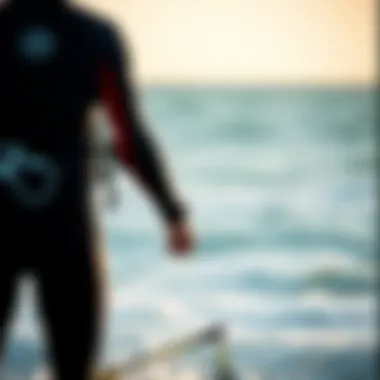
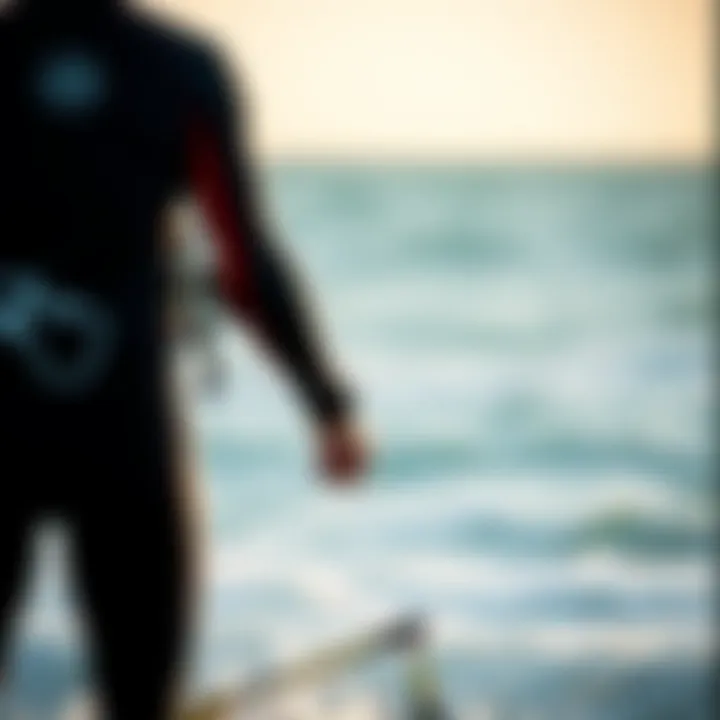
Culmination
By synthesizing expert reviews and community insights, kiteboarders can better arm themselves with the knowledge necessary to choose a wetsuit tailored to their specific needs. The amalgamation of professional insights and peer feedback paints a comprehensive picture of what to expect, fostering informed and thoughtful choices in an activity that hinges profoundly on performance and comfort. Remember, knowledge is power, but shared experiences can elevate your kiteboarding journey, especially in colder waters.
Regional Considerations for Cold Water Wetsuits
When kiteboarding in cold water, the environment you find yourself in can make a world of difference. Understanding regional considerations informs not only the type of wetsuit you should invest in but also gives you a clearer picture of various factors that can impact your overall experience. The colder the water, the more decisive your choices need to be. Certain regions present unique challenges and advantages, making it essential to tailor your gear to fit local conditions.
"Adaptability is key, especially in the unpredictable nature of kiteboarding."
North America
North America boasts a wide range of kiteboarding spots, from the warm Caribbean waters to the frigid currents of the Pacific Northwest. In the northern states and Canada, kiteboarders contend with icy water temperatures, particularly in winter months. The Great Lakes also come into play here, offering both challenges and unique opportunities.
When gearing up in North America:
- Thickness Matters: Many kiteboarders favor wetsuits in the 4/3mm to 5/4mm range during the cooler months, allowing for ample insulation against chilly waters.
- Layering Techniques: It’s common to see kiteboarders layering with limestone neoprene or thermals under their suits.
- Local Surf Culture: Places like Hood River or the Outer Banks may influence the choice of gear, as local weather patterns and wind intensities can be dramatic.
Europe
Europe represents an interesting mélange of kiteboarding locations, ranging from the rocky coastlines of Portugal to the frigid shores of Norway. Each spot has its distinct climate patterns and water temperatures. The thermal variance means that kiteboarders might find themselves swapping suits frequently.
In terms of wetsuits in Europe, here are some significant highlights:
- Custom Fit Considerations: Many European brands provide tailored options, which can enhance comfort significantly.
- Sustainability Focus: Due to a growing interest in green initiatives, eco-friendly wetsuit options are on the rise.
- Region-Specific Regulations: For instance, the environmental laws in places like France mandate certain materials. Knowing these regulations can guide your purchase.
Australia and New Zealand
In the southern hemisphere, both Australia and New Zealand offer stunning kiteboarding experiences but can present different temperature challenges. In Australia, the east coast sees a mix of warmer waters, while locations like Tasmania can turn colder in winter. New Zealand is famed for its diverse weather patterns, causing kiteboarders to prepare for a rollercoaster of thermal conditions.
Here’s how you can prepare for kiteboarding in these regions:
- Seasonal Suit Variations: Australia’s warmer climate often allows for lighter suits, commonly a 3/2mm or short sleeves; however, colder regions will see heavier insulation.
- Local Recommendations: Engaging with local kiteboarding communities or instructors can yield invaluable insights into the right gear.
- Weather Dependent Gear Changes: Sudden shifts in weather can happen; therefore, packing an extra suit or a warmer layering piece is always a smart move.
Considerations relevant to your region can enhance your comfort and performance. When you tailor your equipment for specific water conditions and climate patterns, you often find that it leads to a more enjoyable kiteboarding experience.
Future Trends in Wetsuit Technology
As kiteboarding continues to grow in popularity, the advancements in wetsuit technology become increasingly significant. By keeping a finger on the pulse of trends, you can enhance your experience in cold water and embrace the adventure fully. The focus isn't just on warmth; it's about creating flexibility and ease of movement while still ensuring you stay protected against the chill. The next wave of wetsuit technology holds a treasure chest of innovations that can ultimately change how kiteboarders interact with their environment.
"The right wetsuit can mean the difference between biting cold and embracing the thrill of the ride."
Innovations in Materials
The materials used in wetsuits are progressing in exciting directions. Traditional neoprene has long been the standard, but newer innovations are stepping onto the scene. For example, some manufacturers are exploring the use of limestone-based neoprene which offers a softer touch without sacrificing insulation. This new material not only retains more heat, but it's also lighter, allowing for unmatched buoyancy and comfort.
Additionally, bio-based materials are coming into play. Companies are working hard to develop more environmentally conscious options that reduce the ecological footprint involved in manufacturing wetsuits. These materials can provide competitive insulation qualities while being sustainable, which resonates well with eco-conscious kiteboarders.
Another promising material innovation is the introduction of graphene coatings, which enhance thermal performance without adding bulk. Imagine a suit that is both ultra-thin and provides insulation akin to thicker wetsuits, allowing for greater movement while staying warm.
Performance Enhancements
Another cornerstone of the future in wetsuit technology involves performance enhancements. Kiteboarders need to rely on suits that not only keep them warm but also enhance their overall riding experience. Features such as seamless construction and improved streamlined designs are gaining traction. These advancements help eliminate water entry points, which contributes significantly to maintaining body temperature.
Moreover, integrated technology is becoming more common. Some wetsuits are now being equipped with smart sensors that provide real-time feedback on body temperature or hydration levels. This high-tech twist can be a boon for seasoned kiteboarders who are training or pushing their limits in colder, demanding conditions.
Lastly, practical features like reinforced high-wear areas have seen improvements. These enhancements extend the durability of wetsuits, making them a worthy investment for those who spend their days carving up the water in less-than-friendly conditions.
In summary, staying informed on the future trends in wetsuit technology signifies a leap forward in your kiteboarding adventures. With better materials and performance enhancements, kiteboarders can look forward to increased comfort and capability, empowering them to tackle exhilarating waters even when temperatures dip.
Kiteboarding Techniques for Cold Conditions
Kiteboarding in cold water comes with its own set of challenges and enhancements that can greatly influence the experience on the water. Knowing how to adapt one's techniques is crucial not just for performance, but for safety and comfort. With the right mindset and a few specific practices in place, kiteboarders can tackle the chill head-on, ensuring that every session is as rewarding as possible.
Adapting Techniques for Cold Water
When the temperature dips, adapting techniques for cold water kiteboarding is essential. Firstly, the fundamental riding stance may need slight adjustments. A lower center of gravity helps manage the board better, especially when dealing with gusty winds often seen in colder weather. This stance also aids in enhancing balance and control, as you maneuver through colder waters, where factors like chop become more prevalent.
Moreover, there's a tendency for quick muscle fatigue in chilled environments. Make it a point to keep moving — whether it’s short, controlled maneuvers or continously varying your speed. This will maintain blood circulation and warmth. Incremental approaches to trick execution are also advisable. Instead of attempting elaborate tricks immediately, warm up with simpler moves to prevent unnecessary strain on colder muscles.
Incorporating a proper warm-up routine is vital too. A warm-up doesn’t have to be extensive; simple stretches and mobility exercises can work wonders in preparing your body for the demands of kiteboarding. Focus on areas like the shoulders, hips, and legs — these areas are notably essential for maintaining good posture and control on the board.
Another technique to consider is riding with a friend during colder months. Not only does it elevate morale, but maintaining proximity can also present opportunities for efficient rescue if either of you gets into a tight spot due to cold fatigue.
Safety Precautions
Amid the thrill of kiteboarding in chilly conditions, safety must remain paramount. Cold water can be deceptively inviting, and the risks associated with it should not be underestimated.
- Check the Weather: Knowing the weather can save your skin. Pay attention to wind speeds and potential changes throughout your session.
- Wear a Leash: Ensure your board's leash is in good condition. Losing your board in frigid water can become a hassle, and the last thing you want is to paddle after a runaway board.
- Keep an Eye on Fellow Riders: The buddy system works wonders. Always kiteboard with someone else in close proximity, especially when conditions become more perilous. This ensures immediate help is available in case of emergencies.
- Wear the Right Gear: While this may seem redundant, having a properly fitted wetsuit, protective gloves, and booties is not just smart — it’s imperative to maintaining adequate body temperature and mobility.
- Learn Cold Water Recovery: Familiarize yourself with how to recover from being knocked down. Practicing re-entry techniques can save time and can reduce exposure to the cold water.
"Approach cold water kiteboarding with a mindful attitude. It’s not just about the adrenaline; being careful ensures you can enjoy the ride longer."
In understanding and implementing these kiteboarding techniques for cold conditions, you set yourself up for a more enjoyable and much safer experience on the water. Remember, it's all about adapting to the environment while keeping an eye on your well-being.
Ending
Understanding what it takes to stay warm and comfortable while kiteboarding in cold waters cannot be overstated. This article has delved into various aspects that significantly influence the kiteboarding experience, particularly for those braving the chillier waters. From choosing the right wetsuit based on materials and thickness to ensuring a proper fit, each decision contributes to overall performance, safety, and enjoyment on the water.
Summarizing Key Points
- Cold Water Conditions: Kiteboarding in cold water is more challenging than in warmer climates. A wetsuit is essential to prevent heat loss and maintain performance.
- Wetsuit Types: Various wetsuit types, including full suits, shorties, and hybrids, cater to different preferences and conditions. The choice can affect freedom of movement and thermal insulation.
- Material Matters: Neoprene variations and eco-friendly options play a significant role in comfort and flexibility. It’s vital to choose a wetsuit that aligns with personal values and performance needs.
- Thickness and Fit: Understanding the correct thickness based on season is crucial. A well-fitted wetsuit ensures no water leaks in, maximizing warmth and mobility.
- Maintenance: Regular cleaning and proper storage of wetsuits can extend durability, promoting long-term use and performance benefits.
- Trends and Innovations: Staying updated with the latest trends in wetsuit technology can offer kiteboarders enhanced performance features, aiding them in their adventures.
This summation encapsulates the vital elements every kiteboarder should consider when selecting and utilizing a wetsuit designed for colder water conditions. Arm yourself with this knowledge to elevate your kiteboarding experience, ensuring safety and enjoyment all year round.
Final Recommendations
- Invest Wisely: Opt for higher-quality materials and technologies that best suit your cold water kiteboarding needs. While they may require a higher initial investment, they often yield better performance and durability.
- Test Before Purchase: If possible, try on different suits in-store. Ensure you have a snug yet comfortable fit to avoid restrictions in movement.
- Research Brands: Take the time to research and compare reputable brands. Check reviews and user experiences, as these can provide invaluable insights before making a decision.
- Adapt Techniques: Be mindful of adjusting your kiteboarding techniques in colder waters. This can take some getting used to, but adapting helps maintain safety.





